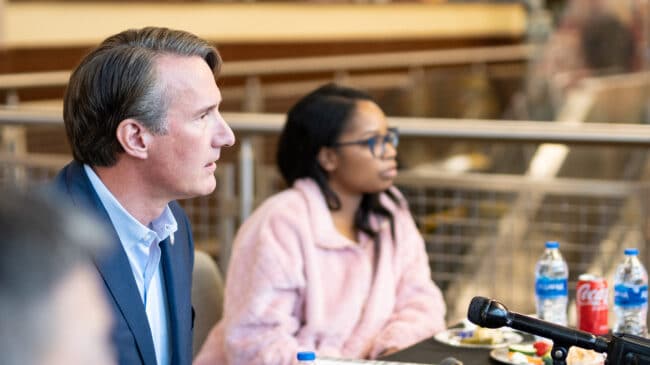Virginia Gov. Glenn Youngkin and Republican lawmakers pushing to expand the state’s school choice programs didn’t get the election results they wanted last month. Still, the newly elected state legislature has an opportunity to expand the public school education options available to students through bipartisan reforms.
Rep. Schyler VanValkenburg (D-Henrico), a teacher who won a state Senate race, said he sees “a key opportunity to change the game on education—to fully fund our schools and ensure access for every child.”
K-12 open enrollment would do just that. Open enrollment lets students transfer to public schools other than their residential-assigned ones as long as seats are available.
It’s popular with parents of school-aged children and increasingly backed by reform-minded conservatives and liberals, with 16 states already implementing it. Virginia and most states only permit public school transfers under limited circumstances. Virginia even allows public school districts to charge transfer students tuition, which many wealthy districts use to effectively block low- and middle-income students from their public schools.
For example, Fauquier County charges $10,000, and Loudoun County Public Schools charges over $14,000 in annual public school tuition to students transferring from outside the district’s boundaries. Even worse, transfer students wanting to attend high schools in the Falls Church Public Schools district must pay $24,000 a year, $6,400 more than the average private high school’s tuition in Virginia.
When public schools can charge tuition to students, they become public in name only.
If public schools have open seats, students should be able to attend them without paying transfer fees. Virginia should ban public school tuition and weaken residential assignment, the tie between housing and schooling that prevents less affluent families from accessing public schools in expensive neighborhoods that are a better fit.
Today, many of Virginia’s public schools have the space to accommodate transfer students. Even before the COVID-19 pandemic, Virginia’s K-12 enrollment had declined for the first time in decades, dropping by more than 2,000 full-time students in 2019. Since then, public school enrollments have rapidly fallen. Despite recovering some K-12 enrollment last year, Virginia had 35,150 fewer students in 2022-23 than in 2019-20. Notably, last school year, only 23 of the state’s school districts, or 18% overall, exceeded the enrollment levels they had before the pandemic.
Virginia’s public school population is unlikely to return to pre-pandemic levels any time soon. The Weldon Cooper Center for Public Service’s Hamilton Lombard at the University of Virginia forecasts public school districts could lose another 45,000 students during the rest of the decade. Lombard says lower birth rates, which have steadily declined since 2007, and the number of families migrating out of state are driving the decrease. Moreover, public schools face increased competition from other school sectors, such as homeschooling and private schools, which boomed during the pandemic.
Teachers unions and public school advocates should view open enrollment as a way to give families greater agency in school selection and encourage them to remain in public schools.
Pro-active public schools can use open enrollment to attract new students. For instance, some small and rural California school districts that were losing local students and at risk of being closed or losing economies of scale used open enrollment to attract transfer students so they could stay open, according to 2016 and 2021 reports by the state’s nonpartisan Legislative Analyst’s Office.
This creates a win-win situation for school districts and students. Public school districts can collect state education funding for each transfer student. Schools are incentivized to develop programs and academic offerings that appeal to families. And students can choose the public schools that are the best fit for them.
Virginia policymakers don’t have to look far to see examples of better public school transfer policies. West Virginia, Delaware, and Washington, D.C. are among the places that let students access any public school free of charge so long as capacity is available.
More than 18,000 D.C. students, 19% overall, attended a traditional public school other than their residential-assigned one during the 2022-23 school year. Transfer applicants rank their school preferences, and assignment is determined by lottery. Students who don’t match with their preferred schools are waitlisted.
Meanwhile, Virginia doesn’t require all school districts with open seats to participate in open enrollment while allowing public schools to charge tuition. As a result, Virginia is tied for worst in the nation in public school open enrollment policies, according to Reason Foundation’s recent analysis.
Policymakers should view open enrollment as a bipartisan win-win situation for public school districts and students. Instead of forcing families to pay public school tuition because they live on the wrong side of the street or blocking children from schools with available seats, open enrollment can give families more choices and improve public education.
A version of this column first appeared in the Washington Examiner.

